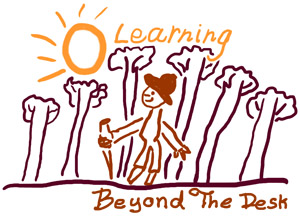So, what does this all mean?
Well, it means leaving the desk idea behind completely. And, along with it, you leave curriculum, worksheets, workbooks, and just about everything else you think of when you think of “school.”
Then, how can we possibly learn?
I’m glad you asked. School is a relatively new phenomenon, having only been around in its current form for about 100-200 years, depending on where you are from. They were established to meet particular needs of the time. However, before those classrooms, controlled school environments and chopped up curricula came into vogue, we had spend thousands of years learning by seeing, doing, experiencing. Believe it or not, this is how we learn best.
Learning Beyond the Desk is a holistic and kinesthetic learning approach using physical engagement to allow students to both learn in new ways and to demonstrate what they have already learned. This method provides a means for the student to use their energy in positive ways. For homeschoolers, this is a whole new world, without desks and boundaries. Yet, even within the confines of the classroom, within the traditional school walls, there are many ways to incorporate these methods and add some life back into the learning process.
What does it mean for students?
In addition to having fun in an otherwise traditionally controlled setting and remembering what they are learning in context, students gain skills in collaborative innovation, empathy, respectful communication, and critical thinking. Not only are they tasked to develop collaborative relationships, but they see the collaborative relationships between teachers and staff.
What does it mean for teachers?
For teachers, LBTD offers a new way to integrate core content, the arts and a very broad range of relevant subjects. Consider including hands-on projects and activities, incorporating guided dramatic play, integrated arts, tableau acting, student-centric learning centers, and so much more. Basically, anything that gets the students out of their chairs and moving, burning off that ADHD energy in a meaningful way, collaborating, connecting, building, and expressing creativity and learning in an integrated way.
Take that even further, and look deeply into your projects. What other subjects does this project incorporate? Math? Science? English? Develop your own collaborative relationships with other teachers. Bring the classes together on the project. Show the students why this topic matters. How it relates to the real world – to their world. Give it meaning.
It just doesn’t get any better for the student does it? What if conventional school was more like this?
What does it mean for homeschoolers?
Isn’t this what homeschooling is all about? With a very small student/teacher ratio and complete lack of bureaucratic red tape, homeschooling parents are free to allow and encourage learning beyond the desk or kitchen table. Homeschooled students are more readily encouraged to explore all aspects of a topic of study or point of interest, not just what will be covered on the next test. In so doing, most often the homeschool methodology naturally leaves the desk behind.
Our own school initiative…
We feel deeply that students should be offered an educational alternative that involves real life learning projects and zero desk time. Homeschooling is the best way to enable this. However, many parents are limited in time and resources, or simply do not feel “qualified” to teach their children or keep them engaged. We have had many requests for these services which are not possible in Virginia. In an effort to help more students and to develop a center where we can help educators as well, we are moving our farm to the urban area of Richmond, VA. The farm will serve as a base for our student-centered alternative high-school. You can learn more about the school and follow our progress on the school’s website: http://localstewu.org.




